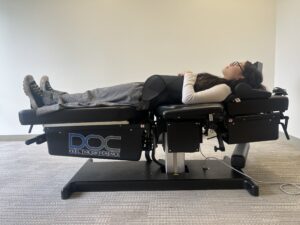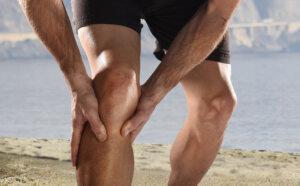
Knee pain can be a major hurdle, whether you’re an athlete, a weekend warrior, or just someone just trying to live pain-free as you go about your daily life. Luckily, Graston Technique offers a knee pain treatment that’s gaining popularity for its effectiveness as a non-surgical knee pain treatment option. But how does this technique work (you want the science!), and how often should you get it for the best results? Let’s dive into the details.
What Is Graston Technique?
Graston Technique is a form of manual therapy chiropractors perform in our offices. And you thought we only cared about backs!
This technique involves using specially designed stainless steel tools to help break down scar tissue, adhesions, and fascia restrictions. Each of these leads to tissues sticking together in abnormal ways, preventing fluid movement and causing strain and pain.
Also called Instrument assisted soft tissue mobilization (IASTM), Graston technique is often used to treat soft tissue injuries, making it an excellent choice for those suffering from knee pain. The technique can be particularly beneficial for conditions like runner’s knee, torn meniscus, knee tendonitis, and even post-surgery recovery, such as after a total knee replacement.
It’s important to mention that Graston does not involve scraping the actual kneecap with these Graston tools. That would hurt!
Rather, it works by improving the function of the muscles, tendons, ligaments, and fascia that support the knee, These tissues could include around the knee, plus thigh and calf muscles that pull on the knee, causing knee pain. Once these adhesions are broken down, tissues can re-form in more harmonious ways. Of course, this happens over several Graston sessions, targeting a small section at a time. This can improve mobility and reduce knee pain over time.

Graston Technique for Knee Pain: Does It Work?
You might be wondering, “Does Graston work for knee pain?” The short answer is yes. Graston knee therapy is effective for reducing pain, improving range of motion, and speeding up recovery. By targeting specific areas around the knee, the Graston Technique helps to:
- Break down scar tissue
- Improve blood flow
- Enhance healing
- Reduce inflammation
Whether you’re dealing with chronic knee pain or recovering from surgery, Graston for knee pain can be a game-changer.
The Compelling Evidence for Graston Technique for Knee Pain
- Studies show Graston can relieve pain and increase range of motion better than exercise alone.
- Another study showed a 50% improvement in knee function.
- A meta-analysis found improvements in functional fitness, lower body muscle strength, and mobility, particularly when combined with an exercise program and chiropractic care and other interventions like Knee on Trac.
- In a randomized controlled trial of female athletes with asymptomatic knee valgus (also called knock-knee because the knees lean inward) showed that Graston technique reduced knee valgus and improved squat form
Explore other forms of Knee Pain Treatment

Learn what it feels like to live pain free! Schedule an initial consultation with comprehensive evaluation and first treatment.
How Often Should Graston Technique Be Done?
A common question we get is: “How often should you get Graston Technique?” The frequency of treatments depends on the severity of your condition and your overall health. Generally, patients start with two sessions per week. After a few weeks, your chiropractor may reduce the frequency as your condition improves.
Here’s a general guideline:
- Acute Injuries: 1-2 times per week
- Chronic Conditions: 2-3 times per week for the first few weeks, then gradually taper off
- Post-Surgery (e.g., Knee Replacement): Start with 2 times per week, then adjust based on recovery
It’s important to listen to your body. If you’re wondering, “How often can you use Graston Technique?” or “How often should Graston be done?”, know that your chiropractor will tailor the treatment to your specific needs. Over-treating is rare but can occur, so it’s crucial to follow professional guidance.
Graston Technique with Exercise
Graston is highly effective when combined a home exercise program, which the chiropractors at Truspine can help you design. We take time to show you the movements and proper exercise form.
Graston with Knee on Trac
Another useful tool is Knee on Trac. This in-office therapy uses a specialized machine to slowly bend and extend your knee while retaining perfect alignment. It trains your knee to use the correct form as it heals. At Truspine, our chiropractors take a comprehensive approach to helping you heal. This is just one technique your chiropractor may recommend with Graston (or rather than the Graston Technique) as part of your personalized treatment plan.
Graston Technique for Specific Knee Conditions
Graston Technique is versatile, making it suitable for various knee-related issues. Here’s how it can help:
- Torn Meniscus: Graston Technique for torn meniscus injuries helps break down scar tissue and promotes healing, reducing pain and improving knee function.
- Knee Tendonitis: Graston Technique for knee tendonitis targets inflammation and adhesions in the tendons, offering relief and preventing further damage.
- Runner’s Knee: For those with runner’s knee, Graston can help to alleviate the discomfort by addressing muscle imbalances and scar tissue that contribute to the condition.
- Total Knee Replacement: Post-surgery, Graston Technique for total knee replacement recovery can aid in reducing scar tissue formation, improving range of motion, and speeding up the rehabilitation process.
The Bottom Line: Should You Try Graston Technique for Knee Pain?
If knee pain is holding you back, Graston knee therapy might be the solution you’ve been looking for. With its proven effectiveness in treating various knee conditions, from knee tendonitis to post-surgery recovery, it’s a versatile and powerful tool in the fight against pain. Every day, our Truspine patients are returning to the activities they love with our support.
Remember, the key to success with Graston Technique for knees is consistency. Follow your knee pain doctor’s recommendations on how often to do Graston Technique, and you’ll be well on your way to healthier, pain-free knees.
So, if you’re tired of knee pain slowing you down, it might be time to ask your chiropractor about incorporating Graston Technique into your treatment plan. After all, healthier knees mean a happier, more active you.
To get on your way to a pain-free life, schedule an initial consultation, including a comprehensive evaluation and first treatment.




